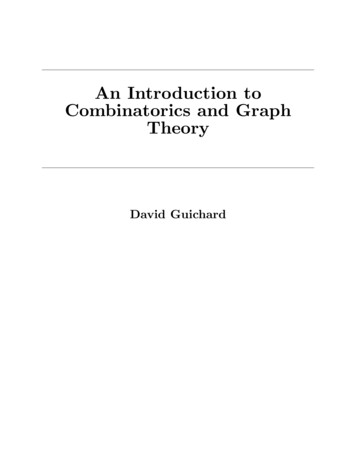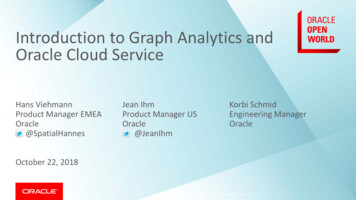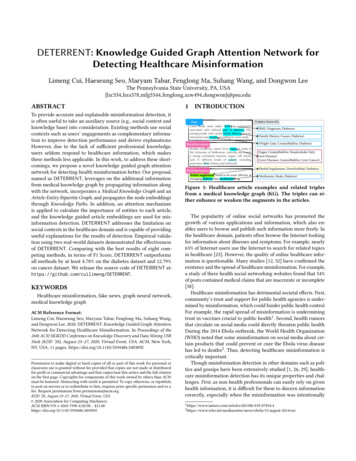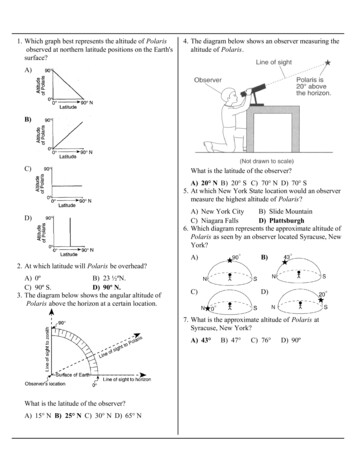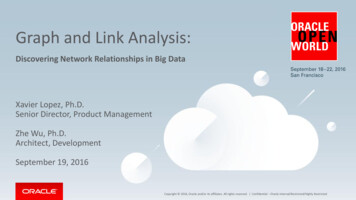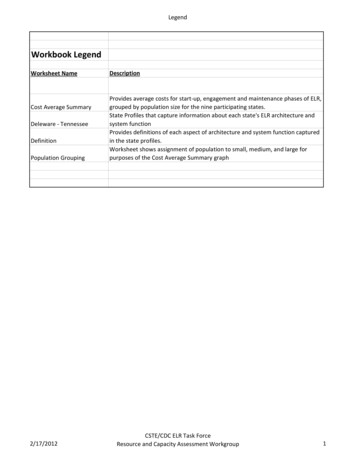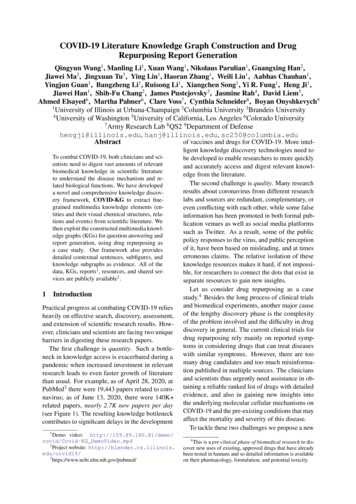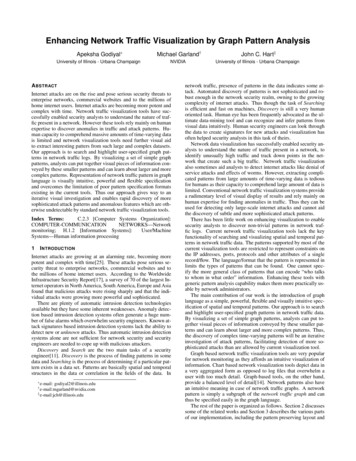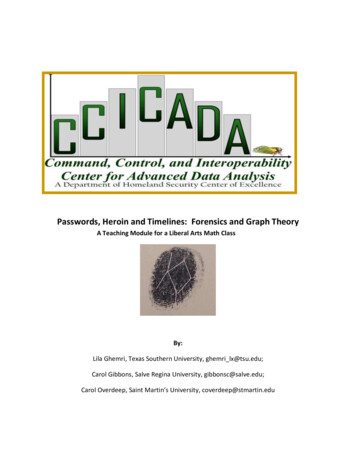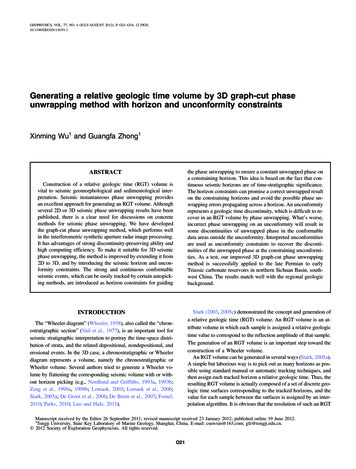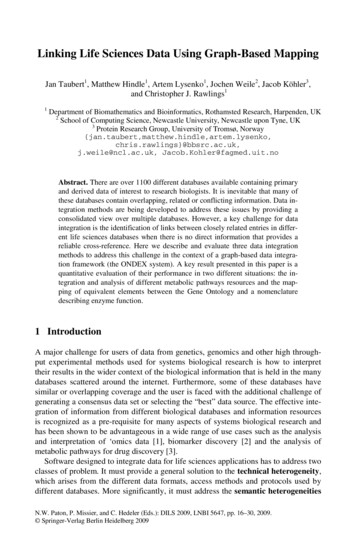
Transcription
www.TechnicalBooksPDF.com
Graph Theorywith Applications to Engineering &Computer ScienceNARSINGH DEOMillican Chair Professor, Dept. of Computer ScienceDirector, Center for Parallel Computation,University of Central FloridaDOVER PUBLICATIONS, INC.Mineola, New Yorkwww.TechnicalBooksPDF.com
CopyrightCopyright 1974 by Narsingh DeoAll rights reserved.Bibliographical NoteThis Dover edition, first published in 2016, is an unabridged republication of the work originallypublished in 1974 by Prentice-Hall, Inc., Englewood Cliffs, New Jersey.Library of Congress Cataloging-in-Publication Data Names: Deo, Narsingh 1936– Title: Graph theory withapplications to engineering and computer science / Narsingh Deo.Description: Dover edition. Mineola, New York: Dover Publications, 2016. Originally published:Englewood Cliffs, New Jersey: Prentice-Hall, Inc., 1974. Includes bibliographical references and index.Identifiers: LCCN 2016008025 ISBN 9780486807935 ISBN 0486807932Subjects: LCSH: Graphy theory. Engineering mathematics.Classification: LCC TA338.G7 D46 2016 DDC 511/.5—dc23 LC record available athttp://lccn.loc.gov/2016008025Manufactured in the United States by RR Donnelley80793201 .com
To the memory of my father,who did not live to realize his greatest ambition—that of witnessing his eldest son matriculate.www.TechnicalBooksPDF.com
t is a Graph?Application of GraphsFinite and Infinite GraphsIncidence and DegreeIsolated Vertex, Pendant Vertex, and Null GraphBrief History of Graph TheorySummaryReferencesProblemsPATHS AND SubgraphsA Puzzle With Multicolored CubesWalks, Paths, and CircuitsConnected Graphs, Disconnected Graphs, and ComponentsEuler GraphsOperations On GraphsMore on Euler GraphsHamiltonian Paths and CircuitsThe Traveling Salesman ProblemSummarywww.TechnicalBooksPDF.com
ReferencesProblems3TREES AND FUNDAMENTAL CIRCUITS3-13-23-33-43-53-63-73-83-93-104TreesSome Properties of TreesPendant Vertices in a TreeDistance and Centers in a TreeRooted and Binary TreesOn Counting TreesSpanning TreesFundamental CircuitsFinding All Spanning Trees of a GraphSpanning Trees in a Weighted GraphSummaryReferencesProblemsCUT-SETS AND CUT-VERTICES4-14-24-34-44-54-64-74-8Cut-SetsSome Properties of a Cut-SetAll Cut-Sets in a GraphFundamental Circuits and Cut-SetsConnectivity and SeparabilityNetwork oblemswww.TechnicalBooksPDF.com
5PLANAR AND DUAL GRAPHS5-15-25-35-45-55-65-75-85-96VECTOR SPACES OF A GRAPH6-16-26-36-46-56-66-76-86-97Combinatorial Vs. Geometric GraphsPlanar GraphsKuratowski’s Two GraphsDifferent Representations of a Planar GraphDetection of PlanarityGeometric DualCombinatorial DualMore on Criteria of PlanarityThickness and CrossingsSummaryReferencesProblemsSets with One OperationSets with Two OperationsModular Arithmetic and Galois FieldsVectors and Vector SpacesVector Space Associated with a GraphBasis Vectors of a GraphCircuit and Cut-Set SubspacesOrthogonal Vectors and SpacesIntersection and Join of W and WsSummaryReferencesProblemsMATRIX REPRESENTATION OF GRAPHS7-17-2Incidence MatrixSubmatrices of A(G)www.TechnicalBooksPDF.com
7-37-47-57-67-77-87-98COLORING, COVERING, AND PARTITIONING8-18-28-38-48-58-69Circuit MatrixFundamental Circuit Matrix and Rank of BAn Application to a Switching NetworkCut-Set MatrixRelationships among Af, Bf, and CfPath MatrixAdjacency MatrixSummaryReferencesProblemsChromatic NumberChromatic PartitioningChromatic PolynomialMatchingsCoveringsThe Four Color ProblemSummaryReferencesProblemsDIRECTED GRAPHS9-19-29-39-49-59-69-79-89-99-10What Is a Directed Graph?Some Types of DigraphsDigraphs and Binary RelationsDirected Paths and ConnectednessEuler DigraphsTrees with Directed EdgesFundamental Circuits in DigraphsMatrices A, B, and C of DigraphsAdjacency Matrix of a DigraphPaired Comparisons and Tournamentswww.TechnicalBooksPDF.com
9-1110ENUMERATION OF GRAPHS10-110-210-310-410-511Acyclic Digraphs and DecyclizationSummaryReferencesProblemsTypes of EnumerationCounting Labeled TreesCounting Unlabeled TreesPólya’s Counting TheoremGraph Enumeration With Pólya’s TheoremSummaryReferencesProblemsGRAPH THEORETIC ALGORITHMS AND COMPUTERPROGRAMS11-1 Algorithms11-2 Input: Computer Representation of a Graph11-3 The Output11-4 Some Basic AlgorithmsAlgorithm 1: Connectedness and ComponentsAlgorithm 2: A Spanning TreeAlgorithm 3: A Set of Fundamental CircuitsAlgorithm 4: Cut-Vertices and SeparabilityAlgorithm 5: Directed Circuits11-5 Shortest-Path AlgorithmsAlgorithm 6: Shortest Path from a Specified Vertex to AnotherSpecified VertexAlgorithm 7: Shortest Path between All Pairs of Vertices11-6 Depth-First Search on a GraphAlgorithm 8: Planarity Testing11-7 Algorithm 9: Isomorphismwww.TechnicalBooksPDF.com
11-8 Other Graph-Theoretic Algorithms11-9 Performance of Graph-Theoretic Algorithms11-10 Graph-Theoretic Computer LanguagesSummaryReferencesProblemsAppendix of Programs12GRAPHS IN SWITCHING AND CODING THEORY12-112-212-312-412-512-613ELECTRICAL NETWORK ANALYSIS BY GRAPH THEORY13-113-213-313-413-513-614Contact NetworksAnalysis of Contact NetworksSynthesis of Contact NetworksSequential Switching NetworksUnit Cube and Its GraphGraphs in Coding TheorySummaryReferencesWhat Is an Electrical Network?Kirchhof’s Current and Voltage LawsLoop Currents and Node VoltagesRLC Networks with Independent Sources: Nodal AnalysisRLC Networks with Independent Sources: Loop AnalysisGeneral Lumped, Linear, Fixed NetworksSummaryReferencesProblemsGRAPH THEORY IN OPERATIONS RESEARCH14-1Transport Networkswww.TechnicalBooksPDF.com
14-214-314-414-514-614-714-814-914-1015Extensions of Max-Flow Min-Cut TheoremMinimal Cost flowsThe Multicommodity FlowFurther ApplicationsMore on Flow ProblemsActivity Networks in Project PlanningAnalysis of an Activity NetworkFurther Comments on Activity NetworksGraphs in Game TheorySummaryReferencesSURVEY OF OTHER APPLICATIONS15-1 Signal-Flow Graphs15-2 Graphs in Markov Processes15-3 Graphs in Computer Programming15-4 Graphs in Chemistry15-5 Miscellaneous ApplicationsAppendix A BINET-CAUCHY THEOREMAppendix B NULLITY OF A MATRIX AND SYLVESTER’S LAWINDEXwww.TechnicalBooksPDF.com
PREFACEThe last two decades have witnessed an upsurge of interest and activity ingraph theory, particularly among applied mathematicians and engineers. Clearevidence of this is to be found in an unprecedented growth in the number ofpapers and books being published in the field. In 1957 there was exactly onebook on the subject (namely, König’s Théorie der Endlichen und UnendlichenGraphen). Now, sixteen years later, there are over two dozen textbooks on graphtheory, and almost an equal number of proceedings of various seminars andconferences.Each book has its own strength and points of emphasis, depending on the axe(or the pen) the author has to grind. I have emphasized the computational andalgorithmic aspects of graphs. This emphasis arises from the experience andconviction that whenever graph theory is applied to solving any practicalproblem (be it in electrical network analysis, in circuit layout, in data structures,in operations research, or in social sciences), it almost always leads to largegraphs—graphs that are virtually impossible to analyze without the aid of thecomputer. An engineer often finds that those real-life problems that can bemodeled into graphs small enough to be worked on by hand are also smallenough to be solved by means other than graph theory. (In this respect graphtheory is different from college algebra, elementary calculus, or complexvariables.) In fact, the high-speed digital computer is one of the reasons for therecent growth of interest in graph theory.Convinced that a student of applied graph theory must learn to enlist the helpof a digital computer for handling large graphs, I have emphasized algorithmsand their efficiencies. In proving theorems, constructive proofs have been givenpreference over nonconstructive existence proofs. Chapter 11, the largest in thebook, is devoted entirely to computational aspects of graph theory, includinggraph-theoretic algorithms and samples of several tested computer programs forsolving problems on graphs. I believe this approach has not been used in any ofthe earlier books on graph theory. The material covered in Chapter 11 and inmany sections from other chapters is appearing for the first time in any textbook.www.TechnicalBooksPDF.com
Yet the applied and algorithmic aspect of this book has not been allowed tospoil the rigor and mathematical elegance of graph theory. Indeed, the bookcontains enough material for a course in “pure” graph theory. The book has beenmade as much self-contained as was possible.The level of presentation is appropriate for advanced undergraduate and firstyear graduate students in all disciplines requiring graph theory. The book isorganized so that the first half (Chapters 1 through 9) serves as essential andintroductory material on graph theory. This portion requires no specialbackground, except some elementary concepts from set theory and matrixalgebra and, of course, a certain amount of mathematical maturity. Although theillustrations of applications are interwoven with the theory even in this portion,the examples selected are short and mostly of the nature of puzzles and games.This is done so that a student in almost any field can read and grasp the first half.The second half of the book is more advanced, and different chapters requiredifferent backgrounds as they deal with applications to nontrivial, real-world,complex problems in different fields. Keeping this in mind, Chapters 10 through15 have been made independent of each other. One could study a later chapterwithout going through the earlier ones, provided the first nine chapters havebeen covered.Since there is more material here than what can be covered in a one-semestercourse, it is suggested that the contents be tailored to suit the requirements of thestudents in different disciplines, for example:1. Electrical Engineering: Chapters 1–9, and 11, 12, and 13.2. Computer Science: Chapters 1–9, 11, 12, and parts of 10 and 15.3. Operations Research: Chapters 1–9, and 11, 14, and parts of 15.4. Applied Mathematics: Chapters 1–11 and parts of 15.5. Introductory “pure” graph theory: Chapters 1–10.In fact, the book grew out of a number of such courses and lecture-seriesgiven by the author at the Jet Propulsion Laboratory, California State Universityat Los Angeles, the Indian Institute of Technology at Kanpur, and the Universityof Illinois at Urbana-Champaign.ACKNOWLEDGMENTSIt is a pleasure to acknowledge the help I have received from differentwww.TechnicalBooksPDF.com
individuals and institutions. I am particularly indebted to Mr. David K. Rubin, adear friend and former colleague at the Jet Propulsion Laboratory; Mr. MatetiPrabhaker, a former graduate student of mine at the Indian Institute ofTechnology, Kanpur; and Professor Jurg Nievergelt of the University of Illinoisat Urbana-Champaign for having read the entire manuscript and made numeroussuggestions for improvements throughout the book.Other friends, colleagues, and students who read parts of the manuscript andmade helpful suggestions are: Professor Harry Lass and Mr. Marvin Perlman ofthe Jet Propulsion Laboratory, Professor Nandlal Jhunjhunwala of CaliforniaState University at Los Angeles, Dr. George Shuraym of Texas Instruments, Mr.Jean A, DeBeule of Xerox Data Systems, Mr. Nicholas Karpov of Bell &Howell, Professor C. L. Liu of the University of Illinois at Urbana-Champaign,Messrs. M. S. Krishnamoorthy, K. G. Ramakrishnan, and Professors C. R.Muthukrishnan and S. K. Basu of the Indian Institute of Technology at Kanpur.I am also grateful to the late Professor George E. Forsythe of StanfordUniversity for his encouragement at the very outset of this project.Support in writing this book was received from the Jet Propulsion Laboratory,the Indian Institute of Technology at Kanpur, and the Computer ScienceDepartment of the University of Illinois at Urbana-Champaign.Just as one does not thank himself, expressing gratitude to one’s wife in publicis not a Hindu custom. For the wife is considered a part of the husband, and hercoauthorship is tacitly assumed in any book her husband writes. There is littledoubt that without Kiran’s help this book would not have been possible.NARSINGH DEOKanpurwww.TechnicalBooksPDF.com
Graph Theorywith Applications to Engineering &Computer Sciencewww.TechnicalBooksPDF.com
1 INTRODUCTION1-1. WHAT IS A GRAPH?A linear† graph (or simply a graph) G (V, E) consists of a set of objects V {v1 v2, . . .} called vertices, and another set E {e1’ e2,. . .}, whose elements arecalled edges, such that each edge ek is identified with an unordered pair (vi, vj) ofvertices. The vertices vi vj associated with edge ek are called the end vertices ofek. The most common representation of a graph is by means of a diagram, inwhich the vertices are represented as points and each edge as a line segmentjoining its end vertices. Often this diagram itself is referred to as the graph. Theobject shown in Fig. 1-1, for instance, is a graph.Observe that this definition permits an edge to be associated with a vertex pair(vi, vi). Such an edge having the same vertex as both its end vertices is called aself-loop (or simply a loop. The word loop, however, has a different meaning inelectrical network theory; we shall therefore use the term self-loop to avoidconfusion). Edge e1 in Fig. 1-1 is a self-loop. Also note that the definition allowsmore than one edge associated with a given pair of vertices, for example, edgese4 and e5 in Fig. 1-1. Such edges are referred to as parallel edges.Fig. 1-1 Graph with five vertices and seven edges.www.TechnicalBooksPDF.com
A graph that has neither self-loops nor parallel edges is called a simple graph.In some graph-theory literature, a graph is defined to be only a simple graph, butin most engineering applications it is necessary that parallel edges and self-loopsbe allowed; this is why our definition includes graphs with self-loops and/orparallel edges. Some authors use the term general graph to emphasize thatparallel edges and self-loops are allowed.It should also be noted that, in drawing a graph, it is immaterial whether thelines are drawn straight or curved, long or short: what is important is theincidence between the edges and vertices. For example, the two graphs drawn inFigs. 1-2(a) and (b) are the same, because incidence between edges and verticesis the same in both cases.Fig. 1-2 Same graph drawn differently.In a diagram of a graph, sometimes two edges may seem to intersect at a pointthat does not represent a vertex, for example, edges e and f in Fig. 1-3. Suchedges should be thought of as being in different planes and thus having nocommon point. (Some authors break one of the two edges at such a crossing toemphasize this fact.)Fig. 1-3 Edges e and f have no common point.A graph is also called a linear complex, a 1-complex, or a one-dimensionalwww.TechnicalBooksPDF.com
complex. A vertex is also referred to as a node, a junction, a point, 0-cell, or an0-simplex. Other terms used for an edge are a branch, a line, an element, a 1-cell,an arc, and a 1-simplex. In this book we shall generally use the terms graph,vertex, and edge.1-2. APPLICATIONS OF GRAPHSBecause of its inherent simplicity, graph theory has a very wide range ofapplications in engineering, in physical, social, and biological sciences, inlinguistics, and in numerous other areas. A graph can be used to represent almostany physical situation involving discrete objects and a relationship among them.The following are four examples from among hundreds of such applications.Königsberg Bridge Problem: The Königsberg bridge problem is perhaps thebest-known example in graph theory. It was a long-standing problem untilsolved by Leonhard Euler (1707-1783) in 1736, by means of a graph. Eulerwrote the first paper ever in graph theory and thus became the originator of thetheory of graphs as well as of the rest of topology. The problem is depicted inFig. 1-4.Two islands, C and D, formed by the Pregel River in Königsberg (then thecapital of East Prussia but now renamed Kaliningrad and in West Soviet Russia)were connected to each other and to the banks A and B with seven bridges, asshown in Fig. 1-4. The problem was to start at any of the four land areas of thecity, A, B, C, or D, walk over each of the seven bridges exactly once, and returnto the starting point (without swimming across the river, of course).Euler represented this situation by means of a graph, as shown in Fig. 1-5. Thevertices represent the land areas and the edges represent the bridges.As we shall see in Chapter 2, Euler proved that a solution for this problemdoes not exist.www.TechnicalBooksPDF.com
Fig. 1-4 Königsberg bridge problem.Fig. 1-5 Graph of Königsberg bridge problem.The Königsberg bridge problem is the same as the problem of drawing figureswithout lifting the pen from the paper and without retracing a line (Problems 2-1and 2-2). We all have been confronted with such problems at one time oranother.Utilities Problem: There are three houses (Fig. 1-6) H1, H2, and H3, each to beconnected to each of the three utilities—water (W), gas (G), and electricity (E)—by means of conduits. Is it possible to make such connections without anycrossovers of the conduits?Fig. 1-6 Three-utilities problem.Figure 1-7 shows how this problem can be represented by a graph—theconduits are shown as edges while the houses and utility supply centers arevertices. As we shall see in Chapter 5, the graph in Fig. 1-7 cannot be drawn inthe plane without edges crossing over. Thus the answer to the problem is no.Electrical Network Problems: Properties (such as transfer function and inputimpedance) of an electrical network are functions of only two factors:1. The nature and value of the elements forming the network, such aswww.TechnicalBooksPDF.com
resistors, inductors, transistors, and so forth.2. The way these elements are connected together, that is, the topology of thenetwork.Fig. 1-7 Graph of three-utilities problem.Since there are only a few different types of electrical elements, the variationsin networks are chiefly due to the variations in topology. Thus electrical networkanalysis and synthesis are mainly the study of network topology. In thetopological study of electrical networks, factor 2 is separated from 1 and isstudied independently. The advantage of this approach will be clearer in Chapter13, a chapter devoted solely to applying graph theory to electrical networks.The topology of a network is studied by means of its graph. In drawing agraph of an electrical network the junctions are represented by vertices, andbranches (which consist of electrical elements) are represented by edges,regardless of the nature and size of the electrical elements. An electrical networkand its graph are shown in Fig. 1-8.www.TechnicalBooksPDF.com
Fig. 1-8 Electrical network and its graph.Seating Problem: Nine members of a new club meet each day for lunch at around table. They decide to sit such that every member has different neighbors ateach lunch. How many days can this arrangement last?This situation can be represented by a graph with nine vertices such that eachvertex represents a member, and an edge joining two vertices represents therelationship of sitting next to each other. Figure 1-9 shows two possible seatingarrangements—these are 1 2 3 4 5 6 7 8 91 (solid lines), and 1 3 5 2 7 4 9 6 8 1(dashed lines). It can be shown by graph-theoretic considerations that there areonly two more arrangements possible. They are 1573928461 and 1 7 9 5 8 3 6 24 1. In general it can be shown that for n people the number of such possiblearrangements isFig. 1-9 Arrangements at a dinner table.www.TechnicalBooksPDF.com
andThe reader has probably noticed that three of the four examples ofapplications above are puzzles and not engineering problems. This was done toavoid introducing at this stage background material not pertinent to graph theory.More substantive applications will follow, particularly in the last four chapters.1-3. FINITE AND INFINITE GRAPHSAlthough in our definition of a graph neither the vertex set V nor the edge setE need be finite, in most of the theory and almost all applications these sets arefinite. A graph with a finite number of vertices as well as a finite number ofedges is called a finite graph; otherwise, it is an infinite graph. The graphs inFigs. 1-1, 1-2, 1-5, 1-7, and 1-8 are all examples of finite graphs. Portions of twoinfinite graphs are shown in Fig. 1-10.Fig. 1-10 Portions of two infinite graphs.In this book we shall confine ourselves to the study of finite graphs, andunless otherwise stated the term “graph” will always mean a finite graph.www.TechnicalBooksPDF.com
1-4. INCIDENCE AND DEGREEWhen a vertex vi is an end vertex of some edge ej, vi and ej are said to beincident with (on or to) each other. In Fig. 1-1, for example, edges e2, e6, and e7are incident with vertex v4. Two nonparallel edges are said to be adjacent if theyare incident on a common vertex. For example, e2 and e7 in Fig. 1-1 are adjacent.Similarly, two vertices are said to be adjacent if they are the end vertices of thesame edge. In Fig. 1-1, v4 and v5 are adjacent, but v1 and v4 are not.The number of edges incident on a vertex vi, with self-loops counted twice, iscalled the degree, d(vi) of vertex vi. In Fig. 1-1, for example, d(v1) d(v3) d(v4) 3, d(v2) 4, and d(v5) 1. The degree of a vertex is sometimes alsoreferred to as its valency.Fig. 1-11 A graph with five vertices and seven edges.Let us now consider a graph G with e edges and n vertices v1, v2, . . . , vn.Since each edge contributes two degrees, the sum of the degrees of all vertices inG is twice the number of edges in G. That is,Taking Fig. 1-1 as an example, once more,d(v1) d( v2) d(v3) d(v4) d(v5) 3 4 3 3 1 14 twice the number of edges.From Eq. (1-1) we shall derive the following interesting result.www.TechnicalBooksPDF.com
THEOREM 1-1The number of vertices of odd degree in a graph is always even.Proof: If we consider the vertices with odd and even degrees separately, thequantity in the left side of Eq. (1-1) can be expressed as the sum of two sums,each taken over vertices of even and odd degrees, respectively, as follows:Since the left-hand side in Eq. (1-2) is even, and the first expression on theright-hand side is even (being a sum of even numbers), the second expressionmustBecause in Eq. (1-3) each d(vk) is odd, the total number of terms in the summust be even to make the sum an even number. Hence the theorem.?A graph in which all vertices are of equal degree is called a regular graph (orsimply a regular). The graph of three utilities shown in Fig. 1-7 is a regular ofdegree three.1-5. ISOLATED VERTEX, PENDANT VERTEX, AND NULLGRAPHA vertex having no incident edge is called an isolated vertex. In other words,isolated vertices are vertices with zero degree. Vertices v4 and v7 in Fig. 1-11, forexample, are isolated vertices. A vertex of degree one is called a pendant vertexor an end vertex. Vertex v3 in Fig. 1-11 is a pendant vertex. Two adjacent edgesare said to be in series if their common vertex is of degree two. In Fig. 1-11, thetwo edges incident on v1 are in series.www.TechnicalBooksPDF.com
Fig. 1-11 Graph containing isolated vertices, series edges, and a pendant vertex.In the definition of a graph G (V, E), it is possible for the edge set E to beempty. Such a graph, without any edges, is called a null graph. In other words,every vertex in a null graph is an isolated vertex. A null graph of six vertices isshown in Fig. 1-12. Although the edge set E may be empty, the vertex set V mustnot be empty; otherwise, there is no graph. In other words, by definition, a graphmust have at least one vertex. †Fig. 1-12 Null graph of six vertices.1-6. A BRIEF HISTORY OF GRAPH THEORYAs mentioned before, graph theory was born in 1736 with Euler’s paper inwhich he solved the Königsberg bridge problem [1-4].† For the next 100 yearsnothing more was done in the field.In 1847, G. R. Kirchhoff (1824-1887) developed the theory of trees for theirapplications in electrical networks [1-6]. Ten years later, A. Cayley (1821-1895)discovered trees while he was trying to enumerate the isomers of saturatedwww.TechnicalBooksPDF.com
hydrocarbons CnH2n 2 [1-3].About the time of Kirchhoff and Cayley, two other milestones in graph theorywere laid. One was the four-color conjecture, which states that four colors aresufficient for coloring any atlas (a map on a plane) such that the countries withcommon boundaries have different colors.It is believed that A. F. Möbius (1790-1868) first presented the four-colorproblem in one of his lectures in 1840. About 10 years later, A. De Morgan(1806-1871) discussed this problem with his fellow mathematicians in London.De Morgan’s letter is the first authenticated reference to the four-color problem.The problem became well known after Cayley published it in 1879 in the firstvolume of the Proceedings of the Royal Geographic Society. To this day, thefour-color conjecture is by far the most famous unsolved problem in graphtheory; it has stimulated an enormous amount of research in the field [1-11].The other milestone is due to Sir W. R. Hamilton (1805-1865). In the year1859 he invented a puzzle and sold it for 25 guineas to a game manufacturer inDublin. The puzzle consisted of a wooden, regular dodecahedron (a polyhedronwith 12 faces and 20 corners, each face being a regular pentagon and three edgesmeeting at each corner; see Fig. 2-21). The corners were marked with the namesof 20 important cities: London, NewYork, Delhi, Paris, and so on. The object inthe puzzle was to find. a route along the edges of the dodecahedron, passingthrough each of the 20 cities exactly once [1-12].Although the solution of this specific problem is easy to obtain (as we shallsee in Chapter 2), to date no one has found a necessary and sufficient conditionfor the existence of such a route (called Hamiltonian circuit) in an arbitrarygraph.This fertile period was followed by half a century of relative inactivity. Then aresurgence of interest in graphs started during the 1920s. One of the pioneers inthis period was D. König. He organized the work of other mathematicians andhis own and wrote the first book on the subject, which was published in 1936 [17].The past 30 years has been a period of intense activity in graph theory— bothpure and applied. A great deal of research has been done and is being done inthis area. Thousands of papers have been published and more than a dozen bookswritten during the past decade. Among the current leaders in the field are ClaudeBerge, Oystein Ore (recently deceased), Paul Erdös, William Tutte, and FrankHarary.SUMMARYwww.TechnicalBooksPDF.com
SUMMARYIn this chapter some basic concepts of graph theory have been introduced, andsome elementary results have been obtained. An attempt has also been made toshow that graphs can be used to represent almost any problem involving discretearrangements of objects, where concern is not with the internal properties ofthese objects but with the relationships among them.REFERENCESAs an elementary text on graph theory, Ore’s book [1-10] is recommended.Busacker and Saaty [1-2] is a good intermediate-level book. Seshu and Reed [113] is specially suited for electrical engineers. Berge [1-1] and Ore [1-9] aregood general texts, but are somewhat advanced. Harary’s book [1-5] contains anexcellent treatment of the subject. It is compact and clear, but it contains noapplications and is written for an advanced student of graph theory. For relatinggraph theory to the rest of topology one should read [1-8], a well-writtenelementary book on important aspects of topology. The entertaining book ofRouse Ball [1-12] contains a variety of puzzles and games to which graphs havebeen applied.1-1. BERGE, C., The Theory of Graphs and Its Applications, John Wiley &Sons, Inc., New York, 1962. English translation of the original book inFrench: Théorie des graphes et ses applications, Dunod Editeur, Paris,1958.1-2. BUSACKER, R. G., and T. L. SAATY, Finite Graphs and Networks: AnIntroduction with Applications, McGraw-Hill Book Company, NewYork, 1965.1-3. CAYLEY, A., “On the Theory of Analytical Forms Called Trees,” Phil.Mag., Vol. 13, 1857, 172–176.1-4. EULER, L., “Solutio Problematis ad Geometriam Situs Pertinantis,”Academimae Petropolitanae (St. Petersburg Academy), Vol. 8, 1736,128–140. English translation in Sci. Am., July 1953, 66–70.1-5. HARARY, F., Graph Theory, Addison-Wesley Publishing Company, Inc.,Reading, Mass., 1969.1-6. KIRCHHOFF, G., “Über die Auflösung der Gleichungen, auf welche manbei der Untersuchungen der Linearen Verteilung Galvanisher Strömegeführt wird,” Poggendorf Ann. Physik, Vol. 72, 1847, 497–508. Englishtranslation, IRE Trans. Circuit Theory, Vol. CT-5, March 1958, 4–7.1-7. KÖNIG, D., Theorie der endlichen und unendlichen Graphen, Leipzig,www.TechnicalBooksPDF.com
1-8.1-9.1-10.1-11.1-12.1-13.1936; Chelsea, New York, 1950.LIETZMANN, W., Visual Topology, American Elsevier PublishingCompany, Inc., New York, 1965. English translation of the German bookAnschauliche Topologie, R. Oldenbourg K. G., Munich, 1955.ORE, O., Theory of Graphs, American Mathematical Society,Providence, R.I., 1962.ORE, O., Graphs and Their Uses, Random House, Inc., New York, 1963.ORE, O., The Four Color Problem, Academic Press, Inc., New York,1967.ROUSE BALL, W., Mathematical Recreations and Essays, London andNew York, 1892; and The Macmillan Company, New York, 1962.SESHU, S., and M. B. REED, Linear Graphs and Electrical
different backgrounds as they deal with applications to nontrivial, real-world, complex problems in different fields. Keeping this in mind, Chapters 10 through 15 have been made independent of each other. One could study a later chapter without going through the earlier
